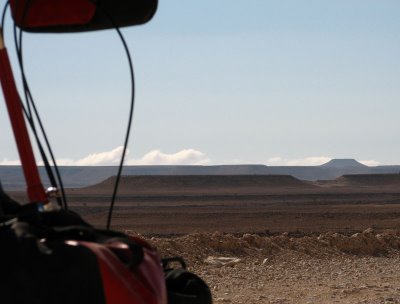the charm of the jol

After a peak down the rim, there's just us, our bikes, an ocean of stones baking in the sun, a dust track fading in the distance, and the name of a town a couple of days ahead - "Huweyrah" - where the track supposedly reconnects to the asphalt road.
The horizon, however a little intimidating, is a breathtaking relief after spending a week between towering canyon walls, the call to prayer bouncing from side to side.

The straight line on our (sort of useless) map turns out be a winding track along the ups and downs of the stone desert. The Jol isn't flat at all, thousands of local depressions - baby wadis - are wedged out of the rock, leaving table mountains reaching up to the 'original' sediment level. Below the map we should have had, showing the Jol in its topographical diversity, the gravel road in white.

You go steeply down and steeply up on the other side, and the slow-footed camels take their time; and, in a blank space of the map, the existence of these ravines makes it impossible to guess even roughly how long a journey will take across the jol. I was finding it just double what I had been told. (fS)
The Jol isn't completely empty either - we come across several water wells surrounded with simple autarkic settlements, a school, some camels, and the ubiquitous Pakistani road engineer. He invites us for a great lunch at his encampment, restocks our supplies, and lets me flip through the engineering drawings for the road he's currently building from Mukallah to Wadi Doan. And he confirms we're on the right track to Huweyrah, more or less halfway.


In the winter of 1937, Freya Stark - "one of the most unconventional and courageous explorers of her time" - crossed the Jol with a British archeological expedition. Traveling by car from Mukhallah to Tarim (opposite direction from us), she remembers her earlier expedition across the Jol, by camel.
We climbed to the empty topmost level of the Jol. Here all looked dead. The plain lay like a stripped athlete, steaked yellow and glistening in the sun. On the horizon, scarce emerging, lay the ridge of Kor Saiban and my former journey. Regretfully I remembered it, thinking how much is taken from the tenuous charm of the jol by rapid travel; its delicate and barren gradations, dependent on the slow transience of light, vanish into drabness under the strident wheels of cars. Even as I lamented, Providence sent a puncture, and gave us ten minutes in the heat of the morning, which the archaeologist improved to an hour by wandering after flints. (fS)
The classic trip across the Jol - a straight shot from the Arabian Sea to Wadi Hadramawt - took 5 to 8 days by camel. We zigzagged from Tarim to Al Mukhalla in a similar amount of time: three days through Wadi Hadramawt, two in Wadi Doan, and three days on the Jol.

Skies on fire at the end of day two, time to set up camp. More stark Jol beauty below...















0 Comments:
Post a Comment